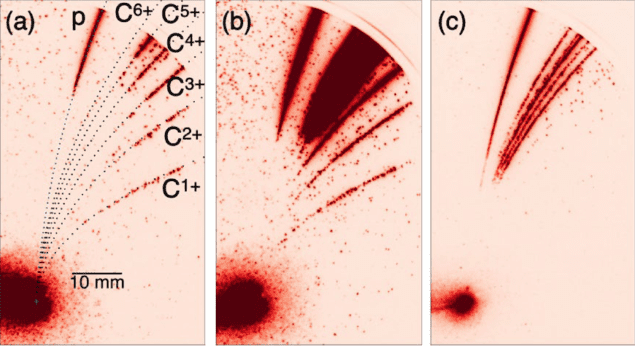
Physicists in Japan and Taiwan have developed a compact, highly efficient method of generating high-energy ion beams by firing a laser pulse at a target made from two layers of graphene. Led by Yasuhiro Kuramitsu at Osaka University, the team showed for the first time that this ultrathin target can yield high-energy beams of protons and carbon ions despite the presence of noise in the laser pulse that tends to destroy thin targets made from conventional materials. The technique could make it possible to produce relativistic beams of ions using less intense lasers, widening the availability of ion-beam technology.
Laser-driven ion acceleration has many applications in medicine, plasma diagnostics and engineering as well as basic science. To bring these capabilities to facilities without the super-intense lasers needed to generate ion beams from robust, micron-thick targets, researchers are exploring ways to make the targets thinner. The problem is that at thicknesses below 100 nm, the targets are much less durable, meaning that they can be destroyed by noisy “pre-pulses” that arrive at the target before the main peak of laser intensity.
So far, the main solution has been to make use of a so-called “plasma mirror” that forms at the leading edge of the laser pulse when the target ionizes. Once ionization occurs, the material rapidly forms a surface that is highly reflective of the laser’s high-intensity peak, while remaining transparent to the noisy pre-pulse. Practically, however, it can be costly to ensure that target surfaces made from conventional 3D materials are thin and flat enough for plasma mirrors to form.
Graphene on target
To avoid this problem, Kuramitsu’s team exploited the unique properties of graphene, which is a two-dimensional sheet of carbon just one atom thick. As the thinnest, lightest, strongest and most transparent of all materials with a comparable thickness, graphene is an ideal candidate for laser ion acceleration. It is also straightforward to produce in the quantities needed for targets.
In their study, which is published in Scientific Reports, Kuramitsu and colleagues developed a large-area suspended graphene (LSG) target featuring a double layer of graphene 2 nm thick. Simulations showed that although the graphene would melt before the main laser peak arrived, the resulting plasma would remain intact until it interacted with the relativistic part of the pulse, generating MeV beams of protons and carbon ions without forming a plasma mirror.

Chirped laser pulses could deliver high-quality ion beams
The researchers went on to demonstrate the durability of their LSG target using the J-KAREN laser at the Kansai Photon Science Institute in Japan. They now hope their breakthrough will extend the advantages of laser-driven ion acceleration into new areas such as targeted cancer therapies, laser-driven nuclear fusion and laboratory-based simulations of astrophysics phenomena.



